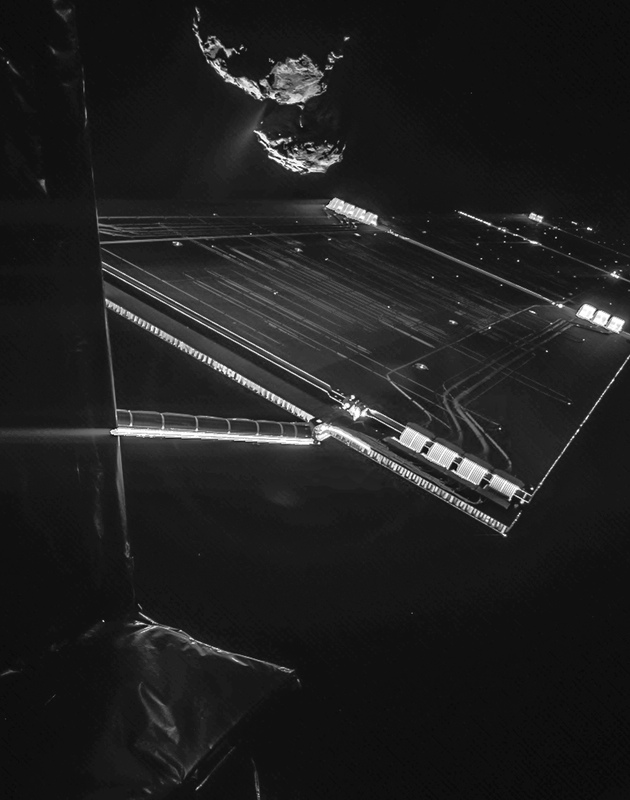Comet 67P/C-G. Image: DLR/Wikimedia Commons
Space probe Rosetta has been chasing down comet 67P/Churyumov-Gerasimenko since 2004, and the plucky spacecraft is finally in the homestretch. But though the comet makes for a gorgeous selfie background, its celestial body odor is apparently pretty rank. According to new readings from Rosetta's Orbiter Spectrometer for Ion and Neutral Analysis (ROSINA), 67P/C-G smells like eggy horse poop."The perfume of 67P/C-G is quite strong, with the odour of rotten eggs (hydrogen sulphide), horse stable (ammonia), and the pungent, suffocating odour of formaldehyde," said Kathrin Altwegg, principal investigator for ROSINA, said in an ESA blog post."This is mixed with the faint, bitter, almond-like aroma of hydrogen cyanide," she continued. "Add some whiff of alcohol (methanol) to this mixture, paired with the vinegar-like aroma of sulphur dioxide and a hint of the sweet aromatic scent of carbon disulphide, and you arrive at the 'perfume' of our comet." These bold odors are watered down by the comet's abundant water and carbon dioxide, but even so, it sounds like a concoction to rival the Gross Jar. And Rosetta's nostrils are pushed all up into it as the spacecraft samples the comet's coma (which is essentially 67P/C-G's atmosphere).It's all for a good cause, however—specifically, to figure out the component parts of 67P/C-G's molecular composition. ROSINA is able to catalogue runoff from the comet with a huge range of shapes and makeups. On the small end, it can catch hydrogen deposits of only one atomic mass unit (AMU), but it can also detect larger, more complex molecules up to 300 AMU.Apparently, 67P/C-G is already giving off a surprisingly diverse collection of materials and ratios. In particular, the spectrometer has revealed that the molecular makeup of the coma varies by region. For example, carbon dioxide is sometimes as abundant as water in one patch, but only makes up 10 percent in another.Broadly speaking, it's fairly similar to other Kuiper Belt comets that have been studied by previous missions, including ESA's Giotto, and NASA's Deep Impact and Stardust spacecraft. In the case of Stardust, samples of the comet Wild 2's runoff were returned to Earth in an aerogel block, revealing the tantalizing presence of amino acids like glycine. It will be interesting to see what other weird combinations ROSINA picks up as it gets even closer to the comet, or when the Philae lander ultimately touches down on the surface on November 11.Given the stench Rosetta has encountered so far, it's a relief that we outsourced this particular space adventure to robots.
These bold odors are watered down by the comet's abundant water and carbon dioxide, but even so, it sounds like a concoction to rival the Gross Jar. And Rosetta's nostrils are pushed all up into it as the spacecraft samples the comet's coma (which is essentially 67P/C-G's atmosphere).It's all for a good cause, however—specifically, to figure out the component parts of 67P/C-G's molecular composition. ROSINA is able to catalogue runoff from the comet with a huge range of shapes and makeups. On the small end, it can catch hydrogen deposits of only one atomic mass unit (AMU), but it can also detect larger, more complex molecules up to 300 AMU.Apparently, 67P/C-G is already giving off a surprisingly diverse collection of materials and ratios. In particular, the spectrometer has revealed that the molecular makeup of the coma varies by region. For example, carbon dioxide is sometimes as abundant as water in one patch, but only makes up 10 percent in another.Broadly speaking, it's fairly similar to other Kuiper Belt comets that have been studied by previous missions, including ESA's Giotto, and NASA's Deep Impact and Stardust spacecraft. In the case of Stardust, samples of the comet Wild 2's runoff were returned to Earth in an aerogel block, revealing the tantalizing presence of amino acids like glycine. It will be interesting to see what other weird combinations ROSINA picks up as it gets even closer to the comet, or when the Philae lander ultimately touches down on the surface on November 11.Given the stench Rosetta has encountered so far, it's a relief that we outsourced this particular space adventure to robots.
Advertisement
